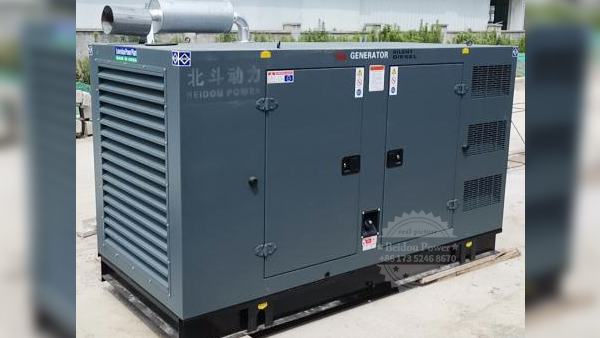The rainproof measures for diesel generator sets need to be comprehensively considered from multiple aspects such as protective structure design, material selection, detail handling and daily maintenance to ensure the safe operation of the equipment in rainy days. The following are the specific rainproof plans and implementation suggestions:
I. Construction of basic protective structures
1. Customized rain shelters/machine rooms
Structural requirements
It adopts a steel structure or aluminum alloy frame, with a waterproof color steel plate or fiberglass reinforced plastic covering the top. The slope is no less than 15° to ensure that rainwater flows quickly.
The height around the shed should exceed the top of the unit by more than 50cm. Detachable rainproof panels can be set on the side to balance ventilation and rain protection.
Case reference: For outdoor temporary power supply scenarios, detachable canvas rain shelters can be used. For long-term fixed scenarios, it is recommended to pour a concrete foundation + steel structure machine room.
2. Use professional rain covers
Key points for selection:
The material should be high-strength ABS engineering plastic or stainless steel, with UV resistance and aging resistance.
The cover body should reserve air inlets and outlets, and install deflector plates inside to prevent rainwater from entering the unit along with the airflow.
A waterproof skirt is set at the bottom edge, combined with a sealing strip to reduce the infiltration of rainwater.
Ii. Waterproofing treatment of key parts
1. Electrical system sealing
Control box and junction box
The sealed box body adopts a protection grade of IP55 or above. The box door is equipped with a silicone rubber sealing ring, and the wire inlet hole uses a waterproof gran head.
The internal electrical components and cable joints should be coated with waterproof glue (such as 704 silicone rubber) to prevent moisture and short circuits.
Generator lead-out end
The outgoing cables are run through galvanized steel pipes and sealed, with the pipe openings sealed with fireproof putty or waterproof sealant.
2. Engine intake and exhaust systems
Air inlet
Install rainproof louvers, with U-shaped deflector pipes inside to prevent rainwater from flowing back in. At the same time, install air filters and replace them regularly.
Exhaust port
A rain cap is installed at the end of the exhaust pipe and tilted downward to prevent rainwater from entering the engine.
Iii. Drainage and Ventilation Design
1. Ground drainage system
Dig drainage ditches around the installation site of the unit with a slope of no less than 0.5% and connect them to the municipal drainage network.
When pouring the base ground, set a 2% drainage slope and apply a waterproof coating (such as polyurethane waterproof paint) on the surface.
2. Ventilation and heat dissipation optimization
On both sides of the rain shelter, there are ventilation louvers (with waterproof baffles) that can be automatically opened and closed, and they are equipped with temperature-controlled exhaust fans. When the unit temperature exceeds 40℃, they will automatically start.
The air inlet and outlet should be kept at a distance of more than 3 meters to prevent short circuits in the airflow.
Iv. Materials and Installation Details
Selection of waterproof materials
The covering material for the greenhouse: Color steel plates (thickness ≥0.5mm) or glass fiber reinforced plastic (FRP) are preferred, as they have strong weather resistance.
Sealing strip: Ethylene propylene diene monomer (EPDM) rubber strip is used, which is resistant to high and low temperatures and anti-aging.
Fasteners: 304 stainless steel bolts are used to prevent rust from causing structural loosening.
2. Installation location requirements
The unit should be installed at a relatively high position (more than 30cm above the ground) to prevent water accumulation and soaking during heavy rain.
Stay away from places such as under the eaves where “water curtains” are likely to form to prevent rainwater from directly washing the equipment.
V. Additional Protection and Maintenance
1. Lightning protection and grounding
A lightning rod (1-2m higher than the canopy body) is installed on the top of the rain shelter and connected to the grounding grid through 40×4mm galvanized flat steel, with a grounding resistance of no more than 10Ω.
The casing of the unit, control box, etc. need to be grounded separately and kept at a distance of more than 3 meters from the lightning protection grounding grid.
2. Daily inspection and maintenance
Regular inspection: Check every quarter whether the structure of the rain shelter is loose, whether the sealing strips are aged, and whether the drainage system is blocked.
Emergency response: After heavy rain, promptly clear the accumulated water on the surface of the unit, blow the electrical components with dry air, and measure the insulation resistance (≥2MΩ).
Vi. Temporary Rain Protection Plan (Applicable to Emergency Scenarios)
Cover the unit with a waterproof tarpaulin, press the bottom down with sandbags, and reserve ventilation holes along the edge of the tarpaulin.
The temporary wiring points should be wrapped in plastic bags and wrapped with waterproof tape to prevent rainwater from coming into contact.
For more questions about the generator set, please call the Beidou Power team. More than ten years of professional production and sales of power generation equipment experience, more professional engineer team to serve you, choose Beidou power is to choose rest assured, welcome on-site factory inspection.
Post time: Jul-21-2025

